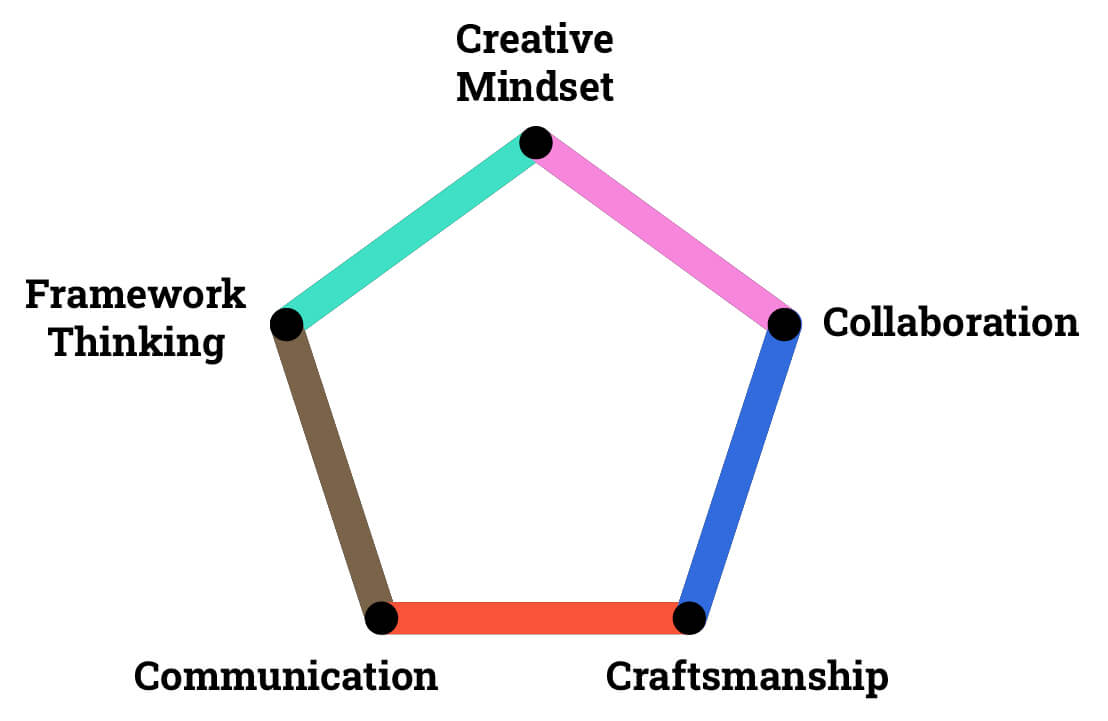Sep 17, 2020 | by Budi Tanrim
Entering product design – Chapter 4: Product designer key skill areas
Update: My view on this topic has changed. Take this with a grain of salt. I felt this model is not intuitive enough and a bit too narrow.
Have you ever wonder what area to improve as a product designer?
I want to introduce the key skill areas of what makes a product designer. I will refer to throughout the series. Using this model, we’ll explore how a product designer can improve. It consists of five areas: Creative mindset, framework thinking, craftsmanship, collaboration, communication.
I’d argue that the strong product designer must 1) have a creative mindset to guide their actions and attitudes, 2) expanding framework thinking to structurize thinking and connect the dots, 3) have a strong craftmanship to produce artifacts, 4) able to collaborate so your team can move as a unit, and 5) be an excellent communicator to articulate your decision or thinking.

You can refer to this model to plan on which area you’re interested in improving, which I will unpack and dive deeper into each skill area.
The stronger the product designer in these five areas, the bigger the influence area would be and, eventually, to solve more complex problems than before.
Creative mindset
The first area will be the creative mindset – that is, a perspective a product designer has toward a specific condition and respond it with the proper attitude.
For example: whether the product designer can adapt in the environment, comfortable navigating through ambiguity, the eagerness to learn from the mistakes, or how persistence she will be in the situation.
A creative mindset is what sets a senior product designer apart from a junior product designer. When a product designer has this creative mindset, she will be able to have the proper attitude, which will help her grow other skill areas continuously.
There are many mindsets we will uncover as we go in this series. In the first chapter, we touched that a strong product designer doesn’t think linearly in the sense of steps to give you an example.
Framework thinking
After you work as a product designer, you will realize how messy the process to build and iterate a product or an experience for a customer.
That’s why framework thinking is essential – that is the ability to analyze and synthesize the information, assess your own thinking, and connect them together with your team.
The more framework you’re exposed, the more abstract or complex problem you can.
The strong designer will not only understand the framework but able to apply it practically with the right tools or techniques. On top of that, I always observe the strong product designer is not only exposing themself to the design-specific frameworks but also absorbing frameworks from the other discipline, such as product, tech, or business.
The more lenses you have, the more you can see.
When you observe yourself struggle to have an abstract discussion, it is one indication that you want to consider to improve this area.
Collaboration
Collaboration is the ability to move with the team toward the desired outcome as a unit. The collaborative product designer can take a wide multidisciplinary perspective to bring alignment to the team so that they can move faster.
The inexperienced product designer will work alone or have a lot of walls throughout their process. They are resulting a slower pace of working and higher misalignment of the work from the objectives. In contrast, a strong product designer will break those walls. They co-create with various stakeholders or even users intensely to move as a unit toward the desired outcome.
Collaboration can benefit the organization to have more successful innovations or to increase the chances of customers to be more satisfied (Steen, Manschot, & De Koning, 2011).
Craftsmanship
Craftsmanship is an essential area for all product designers – that is, the ability to translate abstract ideas into a tangible output – known as artifacts.
It includes interaction and visual design, prototyping to communicate or validate ideas, or research skill.
A strong crafter would be able to iterate their work quickly to help the team translate their product ideas into a tangible working product or an experience used by the end-user. Most people think that craftsmanship is what design is all about.
Also, a strong crafter doesn’t fall in love with their artifacts. They understand that every work is a prototype that can continuously be improved.
Communication
Last but not least. The communication – which is the ability to articulate your thought or thinking, so the other person you’re working with can get your point.
We’ll unpack a lot of techniques like storytelling or expressing your disagreement. The communication will greatly influence your presence as a product designer within the team.
That’s the overview of the model that we’ll explore throughout this series. Stay tuned for the next chapter!
Hi, this blog is no longer active. I move to substack. You can subscribe below or go to newsletter.buditanrim.co



